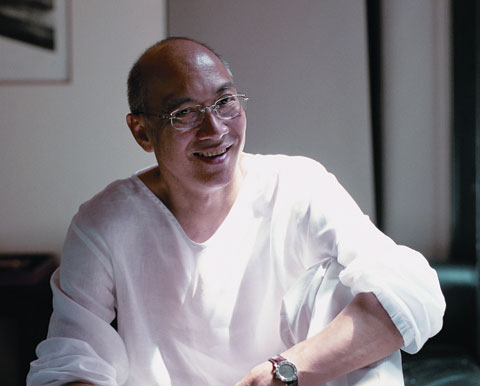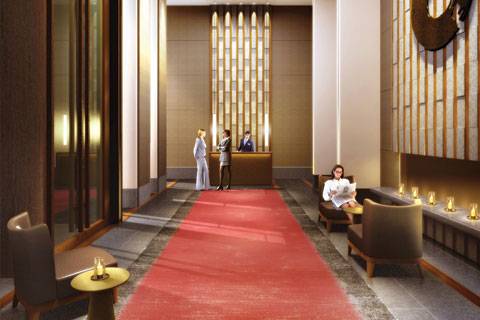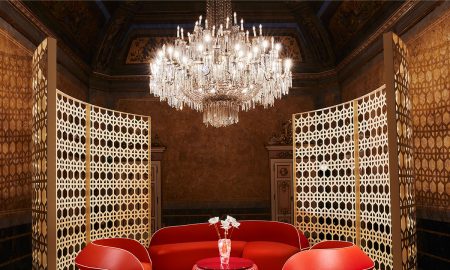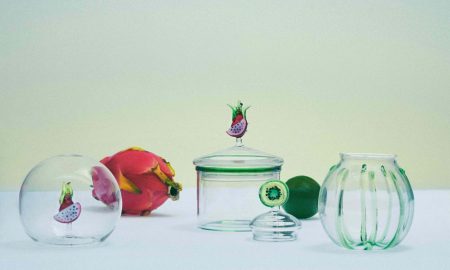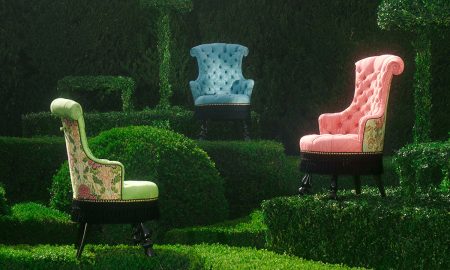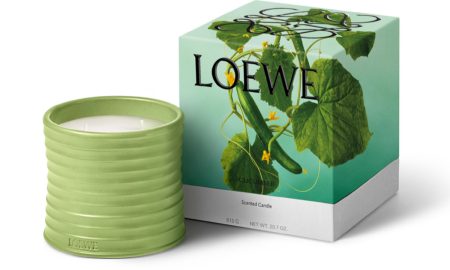Award-winning designer David Tay talks to haute living about his process, one that is grounded in the belief that design is so much more than just a visual message
By Ayesha Khan
In one of his most enjoyable projects, Tay was commissioned by the Singapore Government to create an exhibit of China’s rich history at the Empress Place, one of the city’s most historic buildings.
It’s 8am on a rainy Thursday morning, and David Tay, who just arrived from an exhaustive international itinerary on a 3am flight, is as unperturbed by the weather as he is the early start. He is impeccably dressed and showing no signs of his travels, and greets me with a most unpretentious warmth.
And that’s what David Tay-poet, philosopher, and one of Asia’s foremost designers-is all about: a calming, caring spirit that casts a mystical spell on his clients as he produces some of his finest art. Tay and his team firmly believe that the client should be at the very center of their every project. “Everything is about the client. No two clients are the same, and that is why we do not follow trends… The client is the trend,” he explains. Tay’s designs are steeped in history, guided by tradition, and always innovative. This unique design philosophy has landed him mention in the prestigious “Who’s Who in Interior Design” amongst only a handful of Asian designers, a list that includes I.M. Pei and Kenzo Tange. He designs residences, banks, offices, hotels, and museums with equal ease and ingenious creativity, and with the enduring belief that design is so much more than a visual message. “It’s not about filling a space, but venturing on a journey that awakes all the senses,” Tay asserts, as he explains his philosophy of “thought before form.”
Tay’s mantra of experiential design has attracted clients as far and wide as Bali, New Delhi, and Dubai, and prompted his firm, yi-e-Space (formerly Y2:Space) to expand its presence in China, Indonesia, India, and the United Arab Emirates.
It was during one of his first international hotel projects, the Bali Oberoi, that Tay began to fully understand the magnitude of his inherent gift of design, and his obligation to share it with the world. “For the first time, I saw concepts of grace and finesse far beyond my appreciation of what I thought was elegance in a more superficial lifestyle. I saw beauty and symmetry in forms far more brilliant than my perception or skills in arriving at tastes and style,” he recalls. As a result, Tay channelled the intrinsic beauty in Bali’s exterior environment into interior spaces that appear to be completely drawn from nature. Earthy color palettes and natural materials are uninterrupted by needless adornments, thus creating a new genre of resort interior. And the world took note. The Bali Oberoi has won several accolades and was included among a list of the World’s 100 Best Hotels.
eanwhile, in his native Singapore, Tay’s design expertise was sought out by several prestigious banks and hotel operators such as Hilton, Beaufort, and Pan Pacific. But it was with two particular projects, the Meritus Negara Hotel and Citibank, that Tay truly revolutionized commercial design in Singapore. In Citibank’s flagship Shenton Way outlet, Tay utilized the bank’s corporate identity and colors to create a unique approach to bank design. He then utilized his knowledge of hospitality design to infuse a service-oriented hotel concept with the less personal banking concept. This branch was long regarded as Citibank’s most innovative international branch, and selected as a model branch for the bank’s Asia Pacific operations by Citibank Chairman John Reed. At the Meritus Negara, an intimate boutique hotel service was as important to Tay as the design, and the result was a flawless marriage of the two. In 1997, Meritus Negara became the only hotel in Singapore to win the prestigious worldwide ‘Hotel of the Year’ award presented by Executive Travel in association with AT&T and CNN International.
In one of his most enjoyable projects, Tay was commissioned by the Singapore Government to create an exhibit of China’s rich history at the Empress Place, one of the city’s most historic buildings. “I love museum work,” says Tay. “Such projects come with a wealth of knowledge. As one works with intense historians and passionate curators, we inevitably are inspired by a glowing awareness of being part of a monument of history.”
Tay took his visitors through the glory of the Han Dynasty, Tang Dynasty, the Silk Route, and the Warring States with a dramatic interplay of light, sound, and some of the rarest Chinese artefacts exhibited for the first time outside of China. Dramatic draped silks, a battalion of soldiers arranged on a chessboard, and an eerie yet captivating funerary exhibit all comprised one of the most successful exhibitions of Chinese antiquity the world had ever seen.
At the same time, Tay was able to channel his unfailing design energies into several high profile residential projects. In Singapore’s prestigious Springleaf tower perched atop Anson Road, Tay was invited to create an innovative “SOHO” (small office/home office) unit, which combined the living and office space in a unified design approach. Tay rose to the occasion, creating an exclusive 37th floor penthouse that was all but conventional. A duality between residential and workspace was most important in the design, which features sleek finishes and fine contemporary art set against a neutral color palette. Every space has been carefully planned to match the building’s curved form and sweeping ocean views. An overriding theme of light and shade is also integral to the design. “There is an inner light in every one of us. Guided by the power of light, an illuminated world of spiritual dimensions emerges from the dark recesses of our minds,” says Tay, as he speaks of his most powerful design tool.
When Tay was presented with a chance to interpret the future of design in India, he enlisted a team of young designers to help gain fresh insights and talents. The result is the sought-after Signature Suite 101 at Claridge’s New Delhi, a veritable masterpiece of modern Indian design that is at once steeped in the country’s rich heritage and decidedly forward thinking. Inspired by the colors of the Rang Mahal and titled “The Blue Sapphire,” Tay’s design utilizes his beloved interplay of light and shade, and the myriad textiles and colors found in Indian arts and crafts. Unique artefacts, light fixtures, textiles, and carpets were sourced from around Rajasthan and Gujrat. Streamlined materials and finishes thrust the space into the 21st century, providing timeless elegance with a contemporary edge. “Everything about Suite 101 is Indian- and Indianess not glaring in the eye, but toned with the quiet modernity of contemporary design… speaking as much of the past as of the future,” says Tay.
Soon, an immense opportunity in the burgeoning design haven of Dubai beckoned, and Tay was commissioned to design a contemporary show apartment for the first and only deluxe all-penthouse Le Rêve building in Dubai Marina. Tay’s design once again boldly reinterpreted vernacular design in an awe-inspiring residential spectacle. Characterized by sweeping forms and light fabrics representing billowing sails and Bedouin tents, the contemporary show apartment is unlike any other in Dubai’s omnipresent residential developments.
In the ultimate kudos to Tay’s design prowess, Italy’s most esteemed design house, B&B Italia, commissioned the designer to create a limited edition chair representative of his unique design vision. This honor has been shared by the likes of Antonio Citterio, Mario Bellini, and Paolo Piva. Tay was one of just two Asians to be commissioned by B&B Italia. Once again, Tay did not disappoint, creating a sleek stainless steel and leather clad emblem of contemporary Asian design, accentuated by a flawless ebony and walnut burl back, modelled after the subtle curvature of a woman’s back.
But given his soft-spoken, humble nature, David Tay is certainly not one to rest on his laurels. This constant artist and nomad’s work is never done. Lately, Tay’s projects have him travelling the world fulfilling the design destinies of several exciting new projects. In Bahrain, he is creating a tented dining and entertainment pavilion in the middle of the desert. In Udaipur, India, Tay will join Shristi Corporation and Alfred Wong Partners Singapore as lead designer and master planner of a mega project themed after the colorful mythology and mysticism found in the Indian Vedas. In Indonesia, he is building one of Jakarta’s foremost 250,000 square foot megastore that humbly promises to revolutionize the art of shopping. As we complete this colorful glimpse into Tay’s vast body of work, he leaves us with these lasting words:
“Like a formation of a crystal, flower, or shell, the process is almost always more fascinating and enriching than the appreciation of a creation in its final form. But because we are not Divine, our work will always be far from perfect.”







